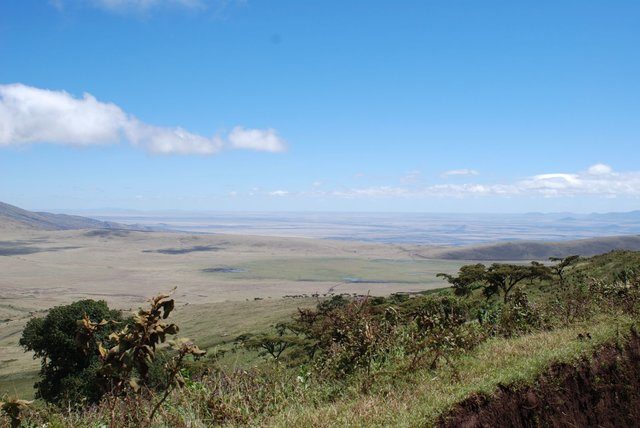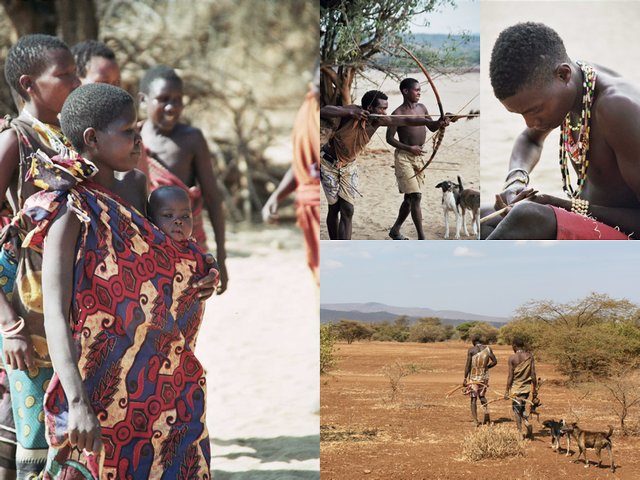
Young male member of the Hadza indigenous people of north-central Tanzania.
The Hadza are a small group of hunter-gatherers inhabiting Tanzania's Rift Valley. While they number just over 1000, fewer than 200 adhere to a traditional lifestyle that includes a diet mainly composed of just five items: meat, berries, a fruit called baobab, tubers, and honey.
Since the Hadza lifestyle does not include refrigerators or supermarkets, their diet fluctuates according to the seasons. This might not be a bad thing, as studies consistently show that these people tend to live long and healthy lives without the use of modern medicine. New research suggests one important reason why this might be the case.
A paper
published in the journal
Science is the first to show that the gut microbiota of the Hadza population varies seasonally, and that this variation corresponds to their seasonally fluctuating dietary intake.
Surviving hunter-gatherer populations are the closest available proxy to a time machine we in the modern industrialized world can climb into to learn about the ways of our remote human ancestors," said senior author Justin Sonnenburg, associate professor of microbiology and immunology at Stanford, in a statement.
The findings confirm that the Hadza microbiota is more diverse than, and substantially different from, that of people within industrialized urban areas. These differences can lead to something rather gross in the guts of urban dwellers.
The cells that line our guts - the interface between self and other - are separated by a layer of mucin that specialized cells produce," lead author Samuel Smits of the department of microbiology and immunology at the Stanford University School of Medicine told Seeker. "This mucin is made up of proteins coated in sugars and serves as a protective barrier, among other things."
"It turns out," he added, "that if one's diet is low in fiber, some microbes will begin to consume the mucin that lines our guts."
Studies on the gut microbiomes of people in industrialized areas show that they are enriched for microbes like those in the genus Akkermansia, which are extremely proficient at consuming mucin.
For the new research, the scientists instead focused on what's going on in the guts of the Hadza. Co-author Jeff Leach of the Human Food Project and King's College London and his helpers had a daunting task: collecting 350 stool samples from 188 separate Hadza individuals over a roughly one-year period. But they achieved this, such that the research team was able to analyze the microbes present in the stool samples over one full seasonal cycle.
The Hadza basically experience two major seasonal periods: a dry climate, when meat, baobab, and tuber consumption tend to be consumed more; and a wet climate, during which berries, tubers, honey, and baobab are more prevalent.
The analysis found that the Hadza gut microbiota variations were in perfect harmony with their seasonal dietary changes. In particular, a subset of microbial species' populations diminished in the wet season, when honey accounted for a significant portion of caloric intake, and rebounded in the dry season, when consumption of fiber-rich tubers peaked."Our own microbiota can change significantly from day to day, or even within hours, in response to what we've been eating," Sonnenburg said.
Nevertheless, the bacterial species whose numbers diminish to sub-detectable levels in the wet season, only to bounce back robustly in the next dry season, are the same ones that are notably absent in the guts of the vast majority of those who populate the industrialized world.

© Sachi GahanRift Valley, Tanzania.
The determination adds to the findings of a 2016
Nature study on mice co-authored by Sonnenberg. When mice were deprived of dietary fiber, their gut microbial species diversity lowered. The diversity was restored if fiber was added back into the individual's diet. If the fiber deprivation was maintained for four generations, however, microbial species that had initially bounced back robustly became permanently lost.
"Fiber's all that's left at the very end of our digestive tract where these microbes live, so they've evolved to be very good at digesting it," Sonnenburg said. "The Hadza get 100 or more grams [3.5 ounces] of fiber a day in their food, on average. We average 15 grams [.5 ounces] per day."
Our bodies likely evolved to crave and process the higher levels of fiber. Smits noted that the Rift Valley is often referred to as the "Cradle of Humanity," a place where early human evolution occurred. Urban dwellers might then benefit from aspects of the Hadza lifestyle.
Smits said that possible lessons include eating more fiber, consuming minimally processed foods, eating quality fruits and vegetables in season, and avoiding damage to "the ecosystems we carry" via too many antibiotics and other means.
Our microbiomes are also affected by the way in which food is prepared.
"The Hadza consume plants that are not chemically treated or washed with chlorinated water," Smits explained. "They prepare the meat of animals they've hunted, and they consume honey whole with larvae and pollen."

© Wikimedia CommonsCollection of images showing the Hadza people of Tanzania.
An accompanying
article in
Science authored by Shyamal Peddada of the National Institute of Environmental Health Science reminds us that the gut microbiome is also affected by exposure to molecules in water, soil and air. All of these may also vary with the seasons.
While the gut microbiome fluctuates, there might be a certain basic establishment of it for each individual, even before birth. That is because a fetus is exposed to its mother's microbiome in addition to other environmental influences. It could even be that Hadza babies born during wet climate seasons have slightly different gut microbiomes than those born in dry seasons, suggesting that the time of one's birth could impact early health, growth and development.
Smits was reminded of yet another form of microbial transference as he said goodbye to the gracious Hadza, who were patient and kind to the researchers during the study.
"As we were getting ready to leave, the Hadza children and adults would affectionately keep wanting to hold my hands or touch me," he recounted. "They appeared to do this a lot with each other as well."
"In their world, distant from hand sanitizers, this touching undoubtedly results in some transference of microbes," he added. "The magnitude and efficiency of this might be questioned, but one of the notable paradoxes of the Hadza microbiome is that, in spite of the fact that they possess one of the most diverse microbiotas on Earth, they share many more of the same species than other human groups."
Comment: Dr. Justin Sonnenburg: Is a disrupted gut microbiome at the root of modern disease?